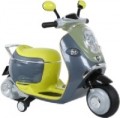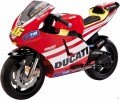Car / motorcycle brand
The brand of a real car or motorcycle from which a children's electric car is copied.
Many toy electric cars are made in the form of copies of real-life technology — this makes them more attractive to children. Most often, such devices copy the most expensive and prestigious models. When choosing, note that different types of transport can be produced within the same brand: for example,
BMW copies can be both cars and motorcycles.
Copies of such brands of real cars and motorcycles are now on the market:
Alfa Romeo,
Aston Martin,
Audi,
Bentley,
BMW,
Bugatti,
Chevrolet,
Ducati,
Ferrari,
Fiat,
Ford,
Hummer,
Jaguar,
Jeep,
Lamborghini,
Land Rover,
Maserati,
Maybach,
Mercedes-Benz,
Mini,
Nissan,
...>Porsche,
Rolls-Royce,
Toyota,
Volkswagen,
Volvo.
Max. baby's weight
The maximum weight of a child for which the electric car is designed. For double models (see "Number of seats"), this paragraph indicates the total maximum load — that is, the maximum total weight of both riders.
It is worth choosing according to this indicator with a certain margin — this will give a guarantee in case of emergency situations (like hitting a wheel in a pit). And if an electric car is purchased “for growth”, with the expectation of using it for several years after purchase, it is advisable to take a larger stock.
Number of seats
The number of seats provided in the machine.
The vast majority of modern electric vehicles are single-seater. However, there are also
two-seater models — so that the child can ride a brother / sister or friend.
Max. speed
The maximum speed that the car can develop under normal conditions is on a flat road with good coverage.
This indicator is directly related to the age category: the older the child, the more speed he needs. So, models for babies under 3 years old usually go no faster than 4 – 5 km/h — this ensures safety and allows the parent to keep up with the machine without any problems; and some teenage
ATVs(age category from 7 to 8 years old) are capable of accelerating to 30 km/h or even more.
There are cars with speed limiters to make driving safer; see "Options" for details.
Number of gears
The number of gears (speeds) provided for in the design of an electric vehicle. Reverse gear, if any, is not taken into account in this case.
Several gears can be provided in cars of almost any age category, except for the youngest. This is done both because of technical necessity, and in order to make the electric car more interesting for the child and to give the young driver the initial skills in handling the gearbox. However, models with automatic transmission are produced, in which the number of gears is purely a conditional moment and does not affect the driving process.
Reverse
The electric vehicle has a
reverse mode. This mode can be very useful in some situations — for example, if the baby drove into a tight space or rested the car in front of an obstacle: an adult (or the driver himself) will not have to pull the “device” manually. Yes, and for educational purposes, this feature will be very useful — the skills of putting back will come in handy later, driving a real car. At the same time, for models of the younger age group (1-3 years), the presence of a reverse gear may turn out to be redundant — a child of this age is not yet sufficiently versed in the features of the machine.
Brake pedal
The car has a separate
brake pedal.
This point is indicated in the specifications because the brake pedal for electric vehicles is far from mandatory: in many models, braking occurs when the gas pedal is released. However, the presence of a separate brake enhances the resemblance to a real car, makes the car more interesting and allows you to develop important driving skills.
Also note that some children's electric cars, including very advanced ones, may not have a brake pedal solely because of design features (for example, in ATVs, the brake is often done manually, on the steering wheel).
Features
-
Remote control. Possibility of remote control of the car from a separate remote control. This function is usually found in models for the little ones and will certainly be appreciated by caring parents: the remote control allows dad or mom to play the role of an instructor, monitor the baby’s movement and intervene in time to protect him from unpleasant collisions. Or, if your child doesn't want to drive the car himself, you can take over the controls and let him enjoy the ride.
—
Smooth engine start. A function that allows the machine to smoothly increase and decrease speed. Without this function, the machine’s engine runs jerkily, which is not very convenient; Smooth start reduces these jerks to a minimum, providing not only convenience, but also additional safety.
-
Speed limiter. Possibility to set a maximum speed limit for the electric vehicle. This function is found in models of the younger age category and is designed mainly for situations when the child is just learning to drive: the limiter does not allow acceleration to a dangerous speed, either intentionally or accidentally, and the parent can keep up with the car without any problems. The blocker is usually controlled in such a way that the child cannot turn it off independently.
-
Seat belts. The electric vehicle has seat belts. Their design
...may be different: some models use a belt over the shoulder and through the waist, like in real cars, others may use two vertical belts holding the child by the shoulders, etc. However, in any case, such belts, in full accordance with the name, provide additional safety for the little driver - not only in case of a collision, but also simply preventing him from falling out of the car during careless movement.
— Rocking function. This feature of a children's electric car is very similar to dancing cars (lowriders). Thanks to a special suspension, it is possible to change the position of the body. Thus, the electric car makes rocking movements, which can either simply amuse the child or rock him to sleep.
— Headlights (light effects). The presence of lighting devices in an electric vehicle. In models of the younger age category, these are the simplest lights that mainly play an entertaining role; In more advanced models, there are also full-fledged headlights that can illuminate the road at night. However, it is worth noting that even the simplest lighting effects have a practical function: they make the car more visible on the road.
— Klaxon (signal). The electric vehicle has a special sound signal (horn). This function is intended primarily to alert others that the vehicle is moving—for example, if a pedestrian walking in the yard is looking in the other direction. Often the horn makes a characteristic “beeping” sound, but there are other sound options.
- Sound effects. The presence of a speaker in the machine through which various sounds can be played. This could be the sound of an engine, a siren, melodies recorded in memory, and in some models even music from a memory card or a player connected via a mini-Jack (see below). The purpose of such sounds is mainly entertainment. Note that the horn described above in this case does not apply to sound effects; it is indicated separately in the characteristics.
- Radio. Own tuner that allows you to receive radio broadcasts - usually in the FM range. The sound is reproduced through the electric vehicle's own speakers.
— Mini-Jack 3.5 mm. The standard 3.5 mm mini-Jack connector in electric vehicles is usually used as an audio input for connecting an external player - MP3 player, mobile phone, etc. By connecting a signal source to this connector, you can play music or other sound (for example, the sound of a powerful engine) through the speakers of an electric car.
- USB input. Classic USB connector. It can have different purposes: in some models you can connect a flash drive with music to this input, others allow you to charge various gadgets from an electric car battery via a USB port. Specific application options for each model should be clarified separately.
— Slot for memory cards. A slot for reading memory cards, usually of the SD standard (however, even this standard has several varieties, so the specific supported formats should be clarified separately). As a rule, this slot is used as a built-in player to play music (or other audio) from a memory card through the speakers of an electric vehicle.
— Bluetooth. Typically, the Bluetooth module is used to wirelessly connect a smartphone and play music from it through the built-in speakers on board a children's electric car. Less commonly, such a connection is used to remotely control the machine.Battery capacity
The capacity of a regular electric vehicle battery.
Theoretically, the larger the battery, the more the car can travel on a single charge. However, in fact, the battery life will also depend on the power consumption of the device, and it is primarily affected by the engine power. In addition, the actual battery capacity is determined not only by the number of ampere-hours, but also by the operating voltage. Therefore, only cars with similar characteristics and the same battery voltage can be compared with each other in terms of capacity; and when evaluating battery life, it is worth looking not so much at the characteristics of the battery, but at the range and continuous driving time directly indicated by the manufacturer.

